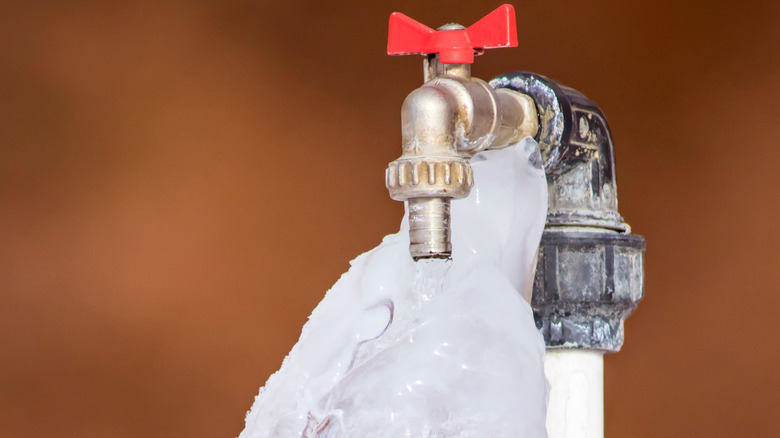Preventing Frozen Plumbing in Cold Weather: Essential Advice
Preventing Frozen Plumbing in Cold Weather: Essential Advice
Blog Article
We've stumbled upon this great article on Helpful Tips to Prevent Frozen Pipes this Winter directly below on the internet and decided it made sense to discuss it with you in this article.

Cold weather can wreak havoc on your pipes, particularly by freezing pipes. Here's how to stop it from occurring and what to do if it does.
Introduction
As temperatures drop, the risk of frozen pipes boosts, possibly leading to expensive fixings and water damages. Recognizing exactly how to stop icy pipes is vital for property owners in cool climates.
Comprehending Frozen Pipelines
What creates pipes to ice up?
Pipelines ice up when exposed to temperatures below 32 ° F (0 ° C) for extended durations. As water inside the pipelines ices up, it broadens, putting pressure on the pipe walls and potentially creating them to burst.
Threats and problems
Frozen pipelines can lead to water system disruptions, home damages, and pricey fixings. Ruptured pipelines can flooding homes and trigger substantial architectural damage.
Indicators of Frozen Pipes
Identifying frozen pipes early can prevent them from bursting.
Exactly how to identify frozen pipelines
Search for reduced water circulation from faucets, unusual odors or noises from pipelines, and noticeable frost on subjected pipelines.
Prevention Tips
Protecting vulnerable pipelines
Cover pipes in insulation sleeves or make use of warm tape to protect them from freezing temperatures. Focus on pipelines in unheated or outside areas of the home.
Home heating strategies
Maintain indoor rooms properly heated, especially areas with plumbing. Open up cupboard doors to permit cozy air to flow around pipes under sinks.
Securing Outside Pipes
Yard tubes and outdoor faucets
Disconnect and drain pipes yard tubes prior to winter. Set up frost-proof faucets or cover exterior taps with shielded caps.
What to Do If Your Pipelines Freeze
Immediate actions to take
If you suspect frozen pipes, keep taps available to alleviate stress as the ice thaws. Make use of a hairdryer or towels taken in hot water to thaw pipes slowly.
Long-Term Solutions
Structural modifications
Think about rerouting pipelines away from exterior walls or unheated locations. Include added insulation to attics, basements, and crawl spaces.
Upgrading insulation
Buy high-quality insulation for pipelines, attic rooms, and wall surfaces. Appropriate insulation helps keep constant temperatures and minimizes the threat of frozen pipes.
Final thought
Avoiding icy pipelines requires positive steps and fast feedbacks. By recognizing the causes, indicators, and preventive measures, property owners can secure their plumbing throughout winter.
6 Proven Ways to Prevent Frozen Pipes and Protect Your Home
Disconnect and Drain Garden Hoses
Before winter arrives, start by disconnecting your garden hoses and draining any remaining water. Close the shut-off valves that supply outdoor hose bibs and leave the outdoor faucet open to allow any residual water to drain. For extra protection, consider using faucet covers throughout the colder months. It’s also important to drain water from any sprinkler supply lines following the manufacturer’s directions.
Insulate Exposed Pipes
Insulating your pipes is an effective way to prevent freezing. Pipe insulation is readily available at home improvement stores and is relatively inexpensive. Pay close attention to pipes in unheated areas such as the attic, basement, crawl spaces, or garage. Apply foam insulation generously to create a buffer against the cold. You can also wrap your pipes in heat tape or thermostat-controlled heat cables for added warmth.
Seal Air Leaks
Inspect your home for any cracks or openings that could let in cold air. Seal any holes around the piping in interior or exterior walls, as well as the sill plates where your home rests on its foundation. Additionally, make sure to keep your garage door closed unless you’re entering or exiting. Leaving it open creates a significant air leak that can lead to frozen pipes.
Allow Warm Air Circulation
During cold snaps, it’s essential to allow warm air to circulate evenly throughout your home. Leave interior doors ajar to promote better airflow. Open kitchen and bathroom cabinets to help distribute heat consistently around the rooms. If you have small children or pets, be sure to remove any household chemicals or potentially harmful cleaners from open cabinets for safety.
Let Faucets Drip
A small trickle of water can make a big difference in preventing ice formation inside your pipes. When temperatures drop significantly, start a drip of water from all faucets served by exposed pipes. This continuous flow helps prevent the water from freezing. Additionally, running a few faucets slightly can relieve pressure inside the pipes, reducing the chances of a rupture if the water inside does freeze.
https://choateshvac.com/6-proven-ways-to-prevent-frozen-pipes-and-protect-your-home/

I came across that blog posting about Winter Plumbing Precautions: Preventing Frozen Pipes while doing a lookup on the search engines. In case you enjoyed our blog entry kindly don't forget to pass it around. We cherish reading our article about Winter Plumbing Precautions: Preventing Frozen Pipes.
Click Report this page